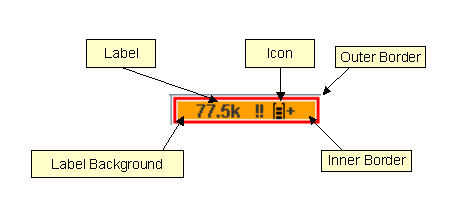Representing alarm counts
The alarm count attributes of IltObject are represented in the table
component using:
- IltDefaultAlarmCountGraphic for raw alarms and traps
- IltImpactAlarmCountGraphic for impact alarms.
The following table interprets some
graphical representations of alarm counts.
Examples of alarm count representations
Representation
|
Description
|
|---|---|

|
99500
(+/- 0.5%) outstanding alarms of severity Minor, some
outstanding alarms of lower severity, and some new alarms of
severity Warning |

|
4 new
alarms of severity Warning |

|
1
Critical acknowledged alarm |

|
5 new
impact alarms of severity Critical High, some outstanding
alarms of lower severity |

|
77500
(+/- 0.5%) outstanding alarms of severity Major High, some
outstanding alarms of lower severity, and some new alarms of
severity Minor High |

Alarm count representation details
Customizing alarm count representations
The alarm count representation can be
customized using the CSS properties listed in the following
table.
CSS properties for alarm count
representations
Property
Name |
Type |
Default
Value |
Description
|
|---|---|---|---|
innerBorderColor
|
Color
|
null
|
Color
of the inner border. |
innerBorderVisible
|
Boolean
|
false
|
Use
true
to show the inner border. The inner border should be
displayed when the alarm count has both new and acknowledged
alarms.
|
innerBorderWidth
|
int
|
1
|
Width
of the inner border. |
label
|
String
|
null
|
Label
used to display the alarm count. This text is parsed and laid
out to conform to the format. |
labelBackgroundColor
|
Color
|
null
|
Color
of the label background. The color corresponds to the
severity of the most severe new alarm. |
outerBorderColor
|
Color
|
null
|
Color
of the outer border. The color corresponds to the severity of
the most severe outstanding alarm. |
outerBorderWidth
|
int
|
2
|
Width
of the outer border. |
icon
|
Image
|
null
|
Icon
used to compose the alarm count. |
iconVisible
|
Boolean
|
true
|
Determines
whether the icon is visible or not. |
iconPosition
|
int
|
IlvConstants.TRAILING
|
Position of the icon relative to the label. If the label
follows the alarm count pattern, the icon is placed before or
after the alarm severity text. Possible values:
IlvConstants.LEADING
or
IlvConstants.TRAILING
|
The CSS functions listed in the following
table are useful to provide values for the alarm count
representation.
CSS functions for alarm count
attributes
Function
Name |
Description
|
Usage
|
|---|---|---|
alarmCount
|
The
outstanding alarm count label |
Parameters:
Alarm type or severity. The alarm type
can have one of the following values:
Default
for raw alarms or traps
Impact
for impact alarms
Specifying no parameter is equivalent to
Default
.
The severity is the String representation of a severity or an
IltAlarmSeverity
.
Examples:
@|alarmCount();
@|alarmCount("Default");
@|alarmCount("Impact");
@|alarmCount("Raw.Major");
@|alarmCount("Impact.CriticalHigh");
|
newAlarmCount
|
The
new alarm count label |
See
alarmCount
|
acknowledgedAlarmCount
|
The
acknowledged alarm count label |
See
alarmCount
|
highestSeverity
|
The
severity of the most severe outstanding alarm |
See
alarmCount
|
highestNewSeverity
|
The
severity of the most severe new alarm |
See
alarmCount
|
highestAcknowledgedSeverity
|
The
severity of the most severe acknowledged alarm |
See
alarmCount
|
alarmSummary
|
The
total amount of new and outstanding alarms |
See
alarmCount
|
newAlarmSummary
|
The
total amount of new alarms |
See
alarmCount
|
acknowledgedAlarmSummary
|
The
total amount of acknowledged alarms |
See
alarmCount
|
severityColor
|
The
color corresponding to a severity |
Parameters:
IltAlarmSeverity
or the String representation of an
IltAlarmSeverity
.
Examples:
@|severityColor("Raw.Major");
@|severityColor(@|highestSeverity());
@|severityColor(@|highestSeverity("Impact"));
|
severityIcon
|
The
icon corresponding to a severity |
Parameters:
IltAlarmSeverity
or the String representation of an
IltAlarmSeverity
.
Examples:
@|severityIcon("Raw.Major");
@|severityIcon(@|highestSeverity());
@|severityIcon(@|highestSeverity("Impact"));
|
How to reproduce the JViews TGO 4.0 styling for alarm count attributes
The following style sheet extract reproduces the JViews TGO 4.0 styling for
alarm count attributes.
// IltObject alarmCount attribute
object."ilog.tgo.model.IltObject/alarmCount" {
class: ilog.tgo.graphic.IltDefaultAlarmCountGraphic;
label: '@|alarmCount()';
toolTipText: '@|alarmSummary()';
labelBackgroundColor: '@|severityColor(@|highestNewSeverity())';
outerBorderColor: '@|severityColor(@|highestSeverity())';
innerBorderColor: white;
innerBorderVisible: '@|highestNewSeverity()!=null &&
@|highestAcknowledgedSeverity()!=null';
}
// IltObject newAlarmCount attribute
object."ilog.tgo.model.IltObject/newAlarmCount" {
class: ilog.tgo.graphic.IltDefaultAlarmCountGraphic;
label: '@|newAlarmCount()';
toolTipText: '@|newAlarmSummary()';
labelBackgroundColor: '@|severityColor(@|highestNewSeverity())';
outerBorderColor: '@|severityColor(@|highestNewSeverity())';
innerBorderColor: white;
innerBorderVisible: false;
}
// IltObject impactAlarmCount attribute
object."ilog.tgo.model.IltObject/impactAlarmCount" {
class: ilog.tgo.graphic.IltImpactAlarmCountGraphic;
label: '@|alarmCount("Impact")';
toolTipText: '@|alarmSummary("Impact")';
labelBackgroundColor: '@|severityColor(@|highestNewSeverity("Impact"))';
outerBorderColor: '@|severityColor(@|highestSeverity("Impact"))';
innerBorderColor: white;
innerBorderVisible: '@|highestNewSeverity("Impact")!=null &&
@|highestAcknowledgedSeverity("Impact")!=null';
}
// IltObject newImpactAlarmCount attribute
object."ilog.tgo.model.IltObject/newImpactAlarmCount" {
class: ilog.tgo.graphic.IltImpactAlarmCountGraphic;
label: '@|newAlarmCount("Impact")';
toolTipText: '@|alarmSummary("Impact")';
labelBackgroundColor: '@|severityColor(@|highestNewSeverity("Impact"))';
outerBorderColor: '@|severityColor(@|highestNewSeverity("Impact"))';
innerBorderColor: white;
innerBorderVisible: false;
}
How to reproduce the JViews TGO 3.5 styling for alarm count attributes
The following style sheet extract reproduces the styling obtained
in JViews TGO 3.5 for
the
IltObject
alarm count attributes. You may want to use it to improve
performance or to ensure compatibility with previous versions of
JViews TGO.
// IltObject alarmCount attribute
object."ilog.tgo.model.IltObject/alarmCount" {
class: javax.swing.JLabel;
text: @|alarmCount();
toolTipText: @|alarmCount();
labelFont: sansserif-plain-12;
labelBackground: '@|severityColor(@|highestSeverity())';
}
// IltObject newAlarmCount attribute
object."ilog.tgo.model.IltObject/newAlarmCount" {
class: javax.swing.JLabel;
text: @|alarmCount();
toolTipText: @|alarmCount();
labelFont: sansserif-plain-12;
labelBackground: '@|severityColor(@|highestNewSeverity())';
}
// IltObject impactAlarmCount attribute
object."ilog.tgo.model.IltObject/impactAlarmCount" {
class: javax.swing.JLabel;
text: @|alarmCount("Impact");
toolTipText: @|alarmCount("Impact");
labelFont: sansserif-plain-12;
labelBackground: '@|severityColor(@|highestSeverity("Impact"))';
}
// IltObject newImpactAlarmCount attribute
object."ilog.tgo.model.IltObject/newImpactAlarmCount" {
class: javax.swing.JLabel;
text: @|newAlarmCount("Impact");
toolTipText: @|newAlarmCount("Impact");
labelFont: sansserif-plain-12;
labelBackground: '@|severityColor(@|highestNewSeverity("Impact"))';
}
How to display the alarm count for a specific alarm severity
Provided there is a
MyObject
business class, with super-class IltObject and a
rawMajorAlarmCount
attribute, the following style sheet produces an alarm count
representation specific to raw alarms of severity
Major
.
// IltObject alarmCount attribute
object."MyObject/rawMajorAlarmCount" {
class: ilog.tgo.graphic.IltDefaultAlarmCountGraphic;
label: '@|newAlarmCount("Raw.Major")';
toolTipText: '@|newAlarmSummary("Raw.Major")';
labelBackgroundColor: '@|severityColor(@|highestNewSeverity("Raw.Major"))';
outerBorderColor: '@|severityColor(@|highestNewSeverity("Raw.Major"))';
innerBorderColor: white;
innerBorderVisible: false;
}